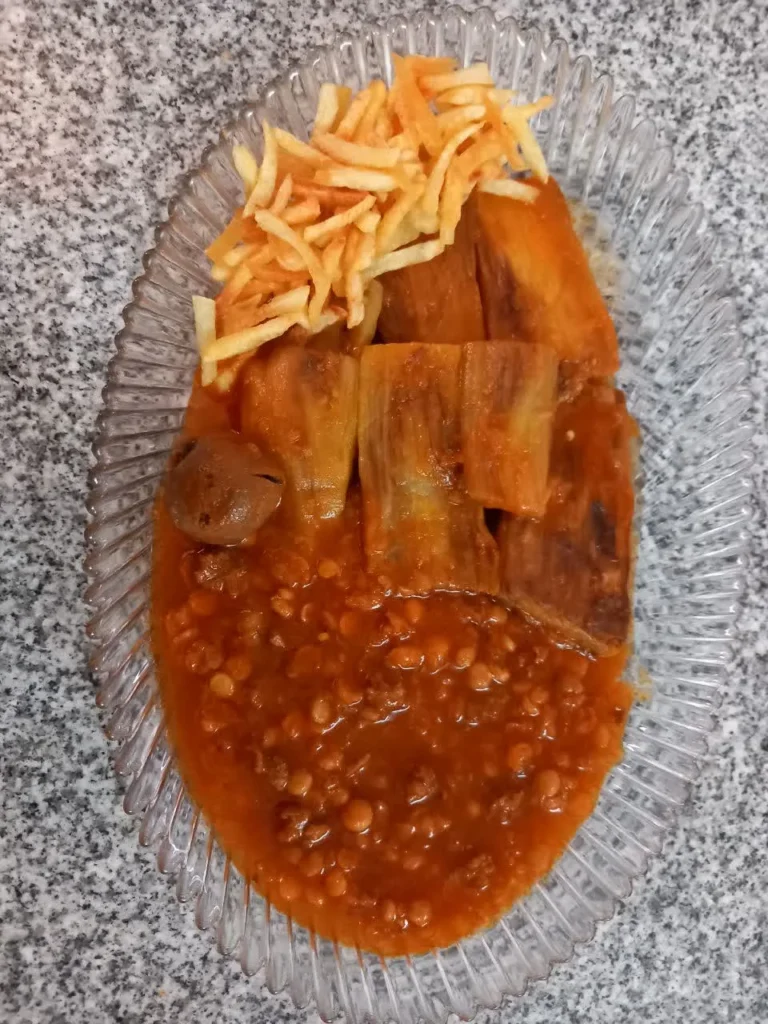Gheimeh Bademjan: A Classic Persian Stew with Eggplant and Split Peas

Among the treasures of Persian cuisine, Gheimeh Bademjan holds a special place. This fragrant, hearty stew combines tender eggplants, yellow split peas, slow-cooked meat, and a touch of tomato paste, finished with the golden aroma of saffron. It’s usually served with fluffy Persian rice (chelow) and sometimes topped with crispy fried potatoes for an extra layer of texture. More than just a meal, Gheimeh Bademjan reflects centuries of culinary tradition, hospitality, and the Persian love for balanced flavors.
In this article, we’ll explore the origins, ingredients, cooking method, variations, serving suggestions, and health benefits of Gheimeh Bademjan—plus tips to make it perfectly every time.
What Is Gheimeh Bademjan?
The word Gheimeh refers to a Persian stew made with split peas and meat, often flavored with dried limes (limoo amani) and saffron. Bademjan means eggplant in Persian. When combined, Gheimeh Bademjan becomes a rich tomato-based stew in which eggplants play the starring role. Unlike the more common Gheimeh Sibzamini (with potatoes), this version highlights the smoky sweetness of fried eggplants.
Origins and Cultural Significance
Persian cuisine is famous for its stews (khoresh), which are usually paired with rice. Gheimeh Bademjan is believed to have originated in central Iran, though it is now cooked in almost every Iranian household. It’s a popular dish during family gatherings, religious events, and festivals. In many Iranian cities, Gheimeh (in different variations) is also served as nazri—a communal meal prepared and distributed for free during religious ceremonies like Muharram.
Key Ingredients of Gheimeh Bademjan
1. Eggplants (Bademjan)
The star of the dish. Long, slender Persian eggplants are preferred for their tender flesh and minimal bitterness. Traditionally, they are peeled, salted, and fried until golden. Some modern cooks bake or air-fry them for a lighter version.
2. Yellow Split Peas (Lapeh)
Yellow split peas give body and texture to the stew. They need to be soaked beforehand to cook evenly and avoid toughness.
3. Meat
Lamb is the traditional choice, but beef works just as well. The meat is cut into small cubes and simmered slowly for tenderness.
4. Tomato Paste
Tomato paste provides richness, color, and depth. It’s usually sautéed with onions to bring out its natural sweetness.
5. Dried Limes (Limoo Amani)
A signature Persian ingredient, dried limes add a tangy, slightly smoky flavor that balances the richness of eggplants and meat.
6. Spices and Aromatics
Onions, turmeric, cinnamon, saffron, and sometimes a hint of nutmeg or cardamom create layers of warmth and aroma.
Step-by-Step Cooking Method
Step 1: Prepare the Eggplants
Peel and slice the eggplants lengthwise.
Sprinkle with salt and let them rest for 30 minutes to remove excess bitterness.
Pat dry and fry until golden, then set aside.
Step 2: Cook the Meat and Split Peas
In a pot, sauté onions until caramelized.
Add turmeric and meat, searing until browned.
Stir in tomato paste and cook for a few minutes to enhance flavor.
Add yellow split peas, dried limes, and enough water or broth.
Simmer gently until the meat is tender and peas are fully cooked.
Step 3: Combine and Finish
Once the stew base is ready, carefully arrange the fried eggplants on top.
Simmer briefly, allowing the flavors to meld without overcooking the eggplants.
Finish with saffron dissolved in warm water for fragrance and color.
Variations of Gheimeh Bademjan
Vegetarian Gheimeh Bademjan: Replace meat with mushrooms or keep it plant-based with just split peas and eggplants.
Chicken Version: Some cooks use chicken instead of lamb or beef for a lighter stew.
Healthier Twist: Bake or grill eggplants instead of frying to cut down on oil.
Festive Style: Garnished with crispy potato sticks (siby dami) for added crunch.
Serving Suggestions
Traditionally, Gheimeh Bademjan is served with:
Steamed Persian Rice (Chelow): Long-grain rice with saffron topping.
Tahdig: The crispy golden crust of rice from the bottom of the pot, often fought over at family tables.
Pickles and Fresh Herbs: Side dishes like torshi (pickled vegetables) and sabzi khordan (fresh herb platter) balance the richness of the stew.
Nutritional Benefits
This stew is not only delicious but also nourishing:
Protein: From lamb or beef, plus plant-based protein from split peas.
Fiber: Eggplants and peas support digestion.
Vitamins & Minerals: Eggplants are high in antioxidants, while saffron provides mood-boosting compounds.
Balanced Meal: When served with rice, it creates a wholesome mix of carbs, proteins, and healthy fats.
Tips for the Perfect Gheimeh Bademjan
Don’t skip soaking the split peas—it prevents them from staying hard.
Fry the tomato paste until it turns darker for deeper flavor.
Add saffron at the end of cooking to preserve its aroma.
Avoid over-stirring once eggplants are added to keep them intact.
Let the stew rest for 15 minutes before serving—flavors will intensify.
Why You Should Try Gheimeh Bademjan
If you’re new to Persian cuisine, Gheimeh Bademjan is a perfect starting point. It combines familiar ingredients—tomatoes, eggplants, and meat—with unique Persian touches like saffron and dried limes. The result is a dish that feels both comforting and exotic. Whether cooked for a family dinner or a special gathering, this stew tells a story of hospitality, tradition, and love for food.
Conclusion
Gheimeh Bademjan is more than just a Persian stew—it’s a celebration of flavor, culture, and tradition. With its tender eggplants, hearty split peas, and saffron-infused aroma, it offers a dining experience that is both comforting and sophisticated. Serve it with Persian rice, share it with loved ones, and enjoy a timeless dish that has been cherished for generations.
